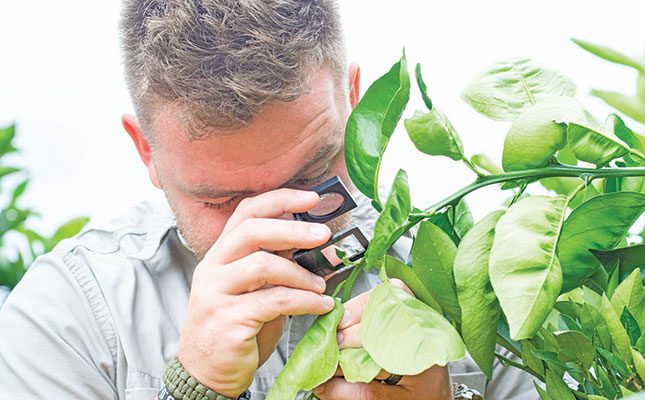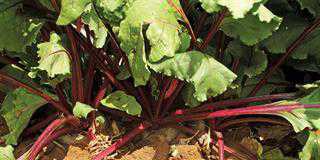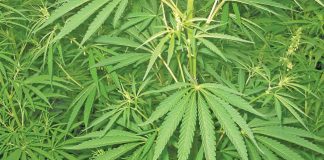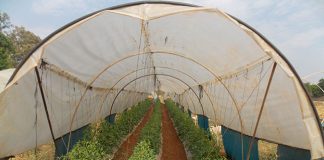
Photo: Mahela Group
Plant pests and diseases can affect the health and growth of crops as well as reduce a farmer’s profitability. Most producers understand the critical importance of monitoring the spread of diseases in humans, but the same principle needs to be applied to plant pests and diseases.
It is essential for farmers to deal with them effectively and in good time. Nonetheless, the list of harmful pests and diseases can make this a daunting task.
Many experts agree that the best way for farmers to know if they need to implement control measures is to look for pests or diseases where they are likely to be found. Plant monitoring is therefore seen as one of the most important managerial tasks in any farming environment, because correct prevention is better than a hasty cure.
Nadine Botha, technical field services representative at Insectec, says that farming practices are increasingly driven by the trend towards implementing sustainable agriculture and ensuring a lower impact on the environment.
“An integrated pest management (IPM) system offers a combination of biological, cultural, physical and chemical control methods to manage pests and diseases sustainably,” she says.
According to Hiresh Ramanand, stewardship coordinator at CropLife South Africa (CropLife SA), the organisation firmly believes that pest monitoring, whether for weeds, disease or insects, forms the basis of any IPM programme.
Regular monitoring
“Regular monitoring enables farmers or their scouts to gather accurate, up-to-date information on the identity and location of pests, and the extent of infestation and damage based on threshold levels relative to the monitoring techniques employed. This ensures that farmers are well informed on the health of their crops. The information collected from monitoring enables farmers to make decisions as to whether corrective action, generally in the form of pesticide, is required.”
Ramanand adds that regular monitoring enables a farmer to apply chemicals only when required, rather than following a rigid spraying programme based on calendar dates.
“A monitoring programme helps to reduce production costs due to more effective use of inputs such as crop protection products.”
Ivan Claassen, technical information specialist at Viking Marketing, emphasises that proper monitoring should be part of any IPM strategy.
“After introducing a monitoring system and training scouts, farmers often complain about certain types of insects they’ve never had on their farms. But in most cases this is because they never looked for these pests and diseases in the past!” says Claassen.
He adds that monitoring is a tool that helps the farmer or IPM controller to time spray applications far more precisely.
“Proper monitoring also helps with the efficacy of the products used. Many chemical products specifically target eggs, larvae or adult insects. Through monitoring, the farmer can determine the life cycle stage of the pest and make calculated decisions on product choice as well as application time.”
Claassen adds that Viking uses software applications to assist with scouting and provides real-time data to assist farmers and their technical teams.
“We offer in-house training to equip scouts with the necessary tools and information to identify various insects as well as life cycles. We also train them in scouting principles so that they know how, when and where to look for pests and diseases.”
Gerrie Ludick, crop-protection specialist at InteliGro, says: “Each member in the crop production value chain has a stewardship responsibility and should take it to heart. For example, the input supplier needs to provide sufficient and current information on product applications.
Training also forms part of this responsibility. InteliGro hosts application workshops across South Africa to address practical field challenges. This includes monitoring of pests and diseases and the correct and safe application of corrective measures.”
Integrated pest management programme components
Botha identifies the major components of an IPM programme as:
- Monitoring pests and crop damage continually;
- Identifying pests accurately;
- Determining the pest infestation level;
- Establishing the threshold levels in order to decide on the action is needed and when to act;
- Employing appropriate prevention methods;
- Implementing a combination of biological, cultural, physical and chemical control methods; and
- Evaluating the effect of pest management actions.
Botha points out that insect damage can occur throughout the growing season, but seedlings and young trees are most at risk. “A monitoring programme throughout the season enables the farmer to manage his practices and prevent serious crop damage. Correct identification of insect pests is necessary in order to avoid economic loss and retain beneficial insects.”
According to Ramanand, record-keeping is critical for two reasons. Firstly, keeping records over time of all observations helps farmers make informed decisions pertaining to their management strategies, allowing for adjustments where necessary.
Secondly, these records, combined with weather data, can be useful in predicting infestation patterns in following seasons.
“Given the current [weak] South African economy and problems at Eskom, farmers need to be smarter in how they do business. Decisions must be informed by data and evidence in order to save on costs in all facets. CropLife SA encourages farmers to monitor pests and keep well-managed records in order to maintain crop protection costs at sustainable levels,” says Ramanand.
Clive Lacock is in charge of IPM at Mahela Group, a third-generation fruit and livestock farming business in Limpopo. He says historical records of infestation periods are of great value to understanding why certain control measures were not effective.
“There’s often a correlation between the infection period and gaps in the chosen control programme. This is where record-keeping can be of value.”
Lacock says visual inspection of individual plants when monitoring a crop is important.
These methods and tools include:
- Using a good hand lens to look for small insects and identify pests;
- Physically observing the crop, environment and soil;
- Placing traps in trees or on the ground;
- Using a sweep net. It is suitable for pests such as aphids, budworm and weevils, but is not useful for counting eggs. The net is effective for finding insects in the crop canopy;
- Shaking individual plants onto paper or sheets to collect insects. A length of light-coloured plastic or material can be placed between rows or under the plants, after which the plants can be shaken over the sheet or bag. The insects can be collected into a container for identification and counting. Individual plants can also be pulled out and then shaken over the sheet of paper or material or over a bucket or sweep net; and
Employing insect traps for monitoring insects flying at night.
“Close examination of plants will be necessary when dealing with very small insects, especially those that live on or near the soil. It might be necessary to crawl under the canopy among the leaf litter,” Lacock advises.
“Some pests are difficult to find, especially those that attack plant roots, so check below as well as above ground. Others may only emerge at night, so appropriate methods for observation must be chosen.”
He says the method will be determined by:
- The stage of crop development;
- The stage of the insect’s life cycle;
- The type of crop being monitored;
- The particular pest being monitored; and
- The time of day at which you monitor.
Botha says that it is important to interpret the results obtained from the insect scouting exercise. “If insects are identified, farmers must determine whether or not the crop is likely to suffer further damage.”
She says further factors to be considered when deciding whether the pest should be controlled include environmental conditions, the level of natural predators or parasites present, and the cost of various control methods.
“At Insectec we provide insect scouting, monitoring and identification training,” says Botha.
Different agents causing plant disease
Disease monitoring is not always easy, as a number of agents can cause plant disease, including viruses, bacteria, fungi, nematodes, insects and even parasitic plants. Ludick says that disease can also rapidly spread by transferring from one host to the next.
In addition, pathogen-related food losses reduce the quantity and quality of food crops, and become a threat to food security due to decreased yield as well as food wastage.
“Early detection by way of monitoring in combination with timely and accurate diagnostics is important in plant pathology. The implementation of efficient and affordable methods for detecting and monitoring plant diseases can greatly facilitate plant protection,” says Ludick.
“As many insects act as vectors for plant diseases, insect monitoring can also help with disease identification. The symptoms of most plant diseases are discernible in parts of a plant such as the leaves, stem, roots and fruit. Identification and diagnosis of the disease can thus be done from the leaf, stem, roots or fruit and by collecting and identifying the insects.”
He adds that early-stage detection is important to prevent yield losses. “Monitoring of plants and diseases at the initial stage is of the utmost importance, as this can help prevent yield or plant loss on a bigger scale and allow early remedial actions.”
Christian Giesel, head of marketing at Syngenta South Africa, says that the application of crop protection products should also form part of a farmer’s IPM programme. He points out that Syngenta launched a revolutionary application that enables farmers not only to choose the correct time to apply crop protection products, but also to help them select the optimal water volume and most appropriate nozzle to avoid drift.
Giesel says effective and optimal spraying depends on:
- Informed application and spraying decisions;
- Efficient application of products with a low impact on the environment; and
- Optimal performance and maximum efficiency of the crop protection products.
Resistance monitoring
Managing resistance in weeds and insect pests in crops is an important part of IPM practices. Elriza Theron, marketing and communications manager at CropLife SA, says the best early-warning system for resistance development in insects or weeds is proper monitoring of expected control.
“Farmers or their staff are the people who visit the lands most often and are generally on the lookout for performance issues. If there’s any problem with a product, it’s extremely important to inform the company marketing it as speedily as possible.”
Monitoring usually involves field surveys to collect seed from potentially pesticide-resistant weeds. These collected seeds can then be tested under controlled conditions to confirm or refute resistance. When resistant weed populations are discovered, steps can be taken to reduce the impact on the crop.
The same applies to suspected insect resistance to insecticides. During monitoring and scouting, insects can be collected and sent for testing.
“Mitigation procedures can reduce the further spread and development of resistance,” Theron adds.
Achieving the best packout rate
Pieter Vorster, director at Mahela Group, says pest and disease monitoring is critical on citrus and other fruit farms, especially for exporters. He adds that there are many phytosanitary requirements that farmers need to adhere to and that they cannot afford to be slack when it comes to pest and disease management.
“Although pest and disease monitoring and control in orchards is a season-long challenge, it’s also a crucial managerial practice on any fruit farm, especially with a view to exporting. Monitoring goes much further than just looking for pests and diseases in trees.
“We also look at low-hanging and dead branches, weeds, damage to orchards done by animals such as baboons or porcupines, as well as irrigation-related aspects in an orchard.”
Lacock points out that all fruit farmers aspire to send the cleanest and healthiest fruit to the packing facility in order to realise the best packout percentage of their fruit.
“If you don’t monitor and act timeously to prevent certain infestations, you’ll not only have a lower yield and a financial loss, but you as an individual farmer may also have an impact on the sustainability of the entire South African citrus export industry.
“It’s expensive to control the various pests and diseases in orchards. Only through proper and continual monitoring can we manage the cost. If you don’t act in good time, you may create the ideal situation for certain pests to multiply and become a permanent feature.”
He adds that digital monitoring enables Mahela to keep accurate record of critical aspects and ensure that disease control is not done blindly.
“We use the digital system on various pests and keep records of infestation numbers, time of infestation and control methods. The historical data help us to predict possible future infestations and with the overall seasonal planning and on-farm IPM strategy.”
Lacock adds that good monitoring practices and prompt identification of possible issues also enable the farm managers to timeously inform the harvesting and packhouse teams regarding possibly postponing harvesting, or the expectation of smaller or bigger fruit.
“All of these aspects have a major impact on the operational planning in the business, and one miscalculation can have a major impact on the profitability at the end of the season.”
Weed control
Lacock says weed control forms an important part of Mahela’s pest management programme.
“Some pests use weeds and low-lying branches as pathways to climb onto the trees. Ants, for instance, hinder the activity of the natural predators that we use in biological pest control. One of the most effective ways to stop ants from climbing onto trees is to prune the low branches near the soil surface and to ensure that the areas around the base of the trees are weedless.
“In addition, dead branches can scratch the outer surface of the fruit, and although this causes cosmetic damage, the fruit cannot be exported.”
He says their scouting teams go through the orchards at least twice a week and are on the lookout for various production aspects. “Our digital platform forms the base of our scouting programme. After each scouting session, certain hotspots can be identified and we can act to address the problems.
“Poor weed control can also result in water and nutrient competition in the root zone, and this is especially important when establishing new orchards.”
Lacock points out that certain diseases, such as Phytophthora and Pythium, occur on trees with poor root development, especially those growing in heavier soils. “We regularly scout for Phytophthora and Citrus nematodes and send samples to the laboratory for analysis. With knowledge, we can act timeously and appropriately,” he says.
Email Christian Giesel at [email protected], Nadine Botha at [email protected], Gerrie Ludick at [email protected], Elriza Theron
at [email protected], Ivan Claassen at [email protected], or Clive Lacock at [email protected].













